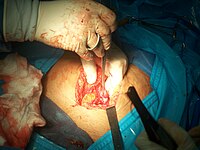
Photo from wikipedia
BackgroundLong-acting reversible contraceptives such as intrauterine devices (IUDs) are highly effective in preventing pregnancy, cost effective, and increasing in popularity. It is unclear whether changes in IUD use are associated… Click to show full abstract
BackgroundLong-acting reversible contraceptives such as intrauterine devices (IUDs) are highly effective in preventing pregnancy, cost effective, and increasing in popularity. It is unclear whether changes in IUD use are associated with changes in rates of irreversible tubal sterilization. In this analysis, we evaluate changes in rates of tubal sterilization, insertion of copper or levonorgestrel (LNG) IUDs, and related complications over time.MethodsData were obtained from a retrospective claims database (OptumTM ClinformaticsTM Data Mart) of women aged 15 to 45 years who underwent insertion of copper or LNG IUD or tubal sterilization between 1/1/2006 and 12/31/2011. Outcomes of interest included annual rates of insertion or sterilization and annual rates of potential complications and side effects.ResultsThe number of women included in the analysis each year ranged from 1,870,675 to 2,016,916. Between 2006 and 2011, copper IUD insertion claim rates increased from 0.18 to 0.25% and LNG IUD insertion claim rates increased from 0.63 to 1.15%, while sterilization claims decreased from 0.78 to 0.66% (P < 0.0001 for all comparisons). Increases in IUD insertion were apparent in all age groups; decreases in tubal sterilization occurred in women aged 20 to 34 years. The most common side effects and complications were amenorrhea (7.36–11.59%), heavy menstrual bleeding (4.85–15.69%), and pelvic pain (11.12–14.27%). Significant increases in claims of certain complications associated with IUD insertion or sterilization were also observed.ConclusionBetween 2006 and 2011, a decrease in sterilization rates accompanied an increase in IUD insertion rates, suggesting that increasing numbers of women opted for reversible methods of long-term contraception over permanent sterilization.
Journal Title: Reproductive Health
Year Published: 2017
Link to full text (if available)
Share on Social Media: Sign Up to like & get
recommendations!